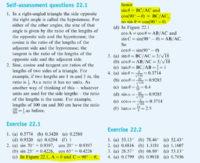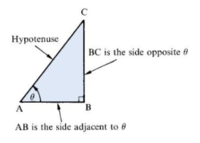First, do you understand that, in any triangle, the three angles add to 180 degrees? That's a basic geometry fact and crucial to trigonometry. Second, surely you understand that "sine" and "cosine" are defined in terms of a right triangle, one of the angles necessarily measures 90 degrees. Since the three angles in any triangle add to 180 degrees and one of the angles in a right triangle the other two angles must add to 180- 90= 90 degrees. If one of the acute angles 30 degrees the other is 90- 30= 60 degrees.
Now, "cosine" is defined as "near side divided by hypotenuse" while "sine" is defined as "opposite side divided by hypotenuse". What are "near side" and hypotenuse? Each angle lies between two sides of the triangle. For the two acute angles, one of those sides is the hypotenuse. The other is the "near side" to that angle. And, of course, the third side of the triangle, directly across the triangle from that angle is the "opposite side".
The crucial point for this is that when you switch from one angle to the other, you swap "near" and "opposite" and so you also swap "sine" and "cosine". Again, if one angle is a right triangle is 30 degrees, the other must be 90- 30= 60 degrees. Using the calculator that comes with windows, we that sin(30)= 0.5 and that cos(60)= 0.5.
We can see that without using a calculator. I assume you know that a "equilateral triangle" has all three sides the same length- call that length "s". And all three angles are the same so, since the angle in any triangle add to 180, each angle is 180/3= 60 degrees. Now draw a line from any one vertex perpendicular to the opposite side. Of course, being a perpendicular, it makes right angles with that side so divides the equilateral triangle into two right triangles. It is easy to show, geometrically, that this perpendicular bisects both the opposite side and the vertex. The opposite side has length s/2 and the angle at the vertex is 60/2= 30. That is, we have two right triangles, each with angles 60 degrees and 30 degrees, hypotenuse of length s and side opposite the 30 degree angle s/2. Looking at the 30 degree angle, that s/2 length side is "opposite" so \(\displaystyle sin(30)= \frac{\frac{s}{2}}{s}= \frac{1}{2}\). Looking at the 60 degree angle, that s/2 length side is "near" so \(\displaystyle cos(30)= \frac{\frac{s}{2}}{s}= \frac{1}{2}\). That is cos(60)= sin(30)= sin(90- 60) and sin(60)= cos(30)= cos(90- 30).
We can use the "Pythagorean theorem", that in any right triangle with hypotenuse of length c and legs of length a and b, \(\displaystyle a^2+ b^2= c^2\), to calculete
Sine of 30 degrees is




